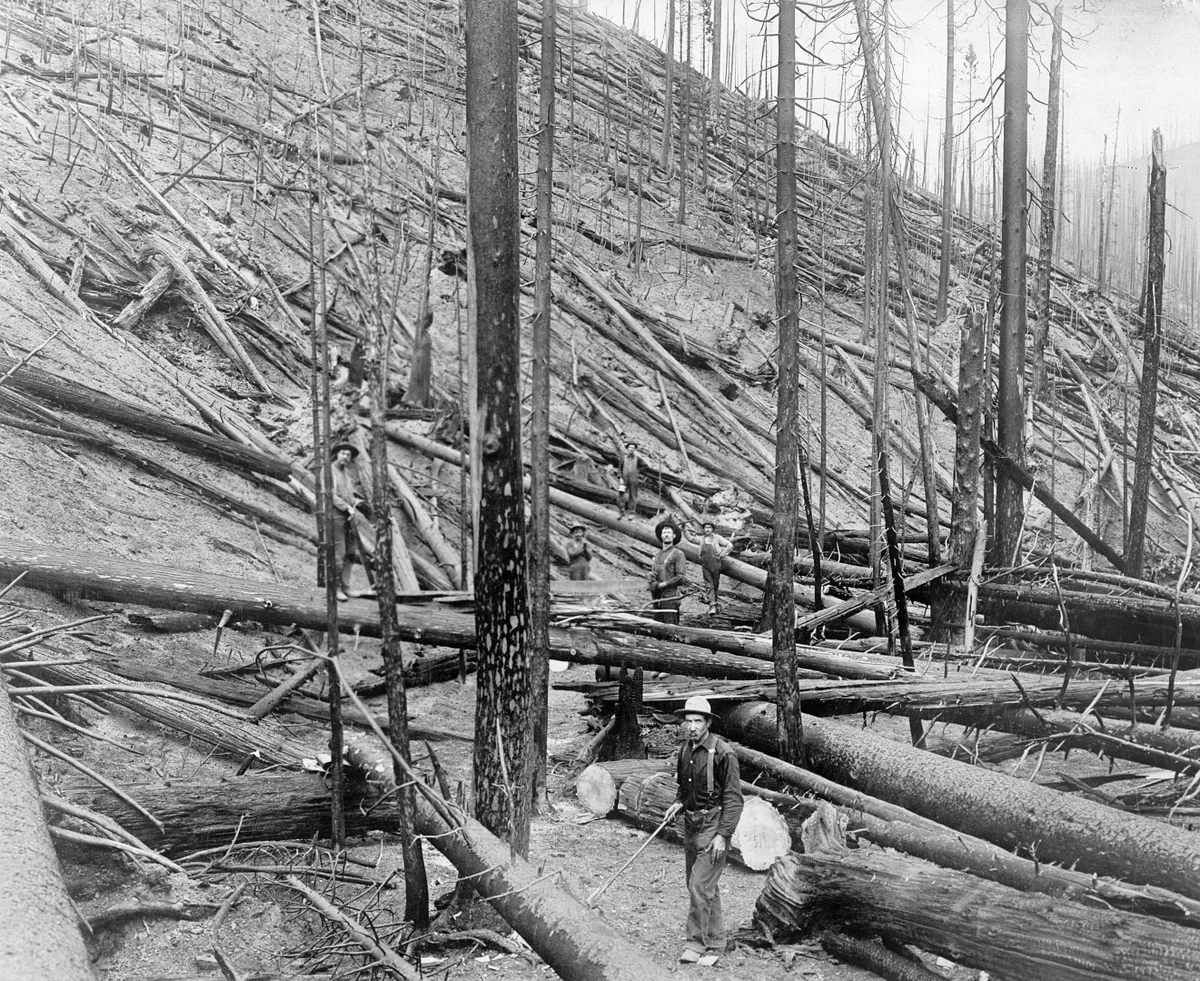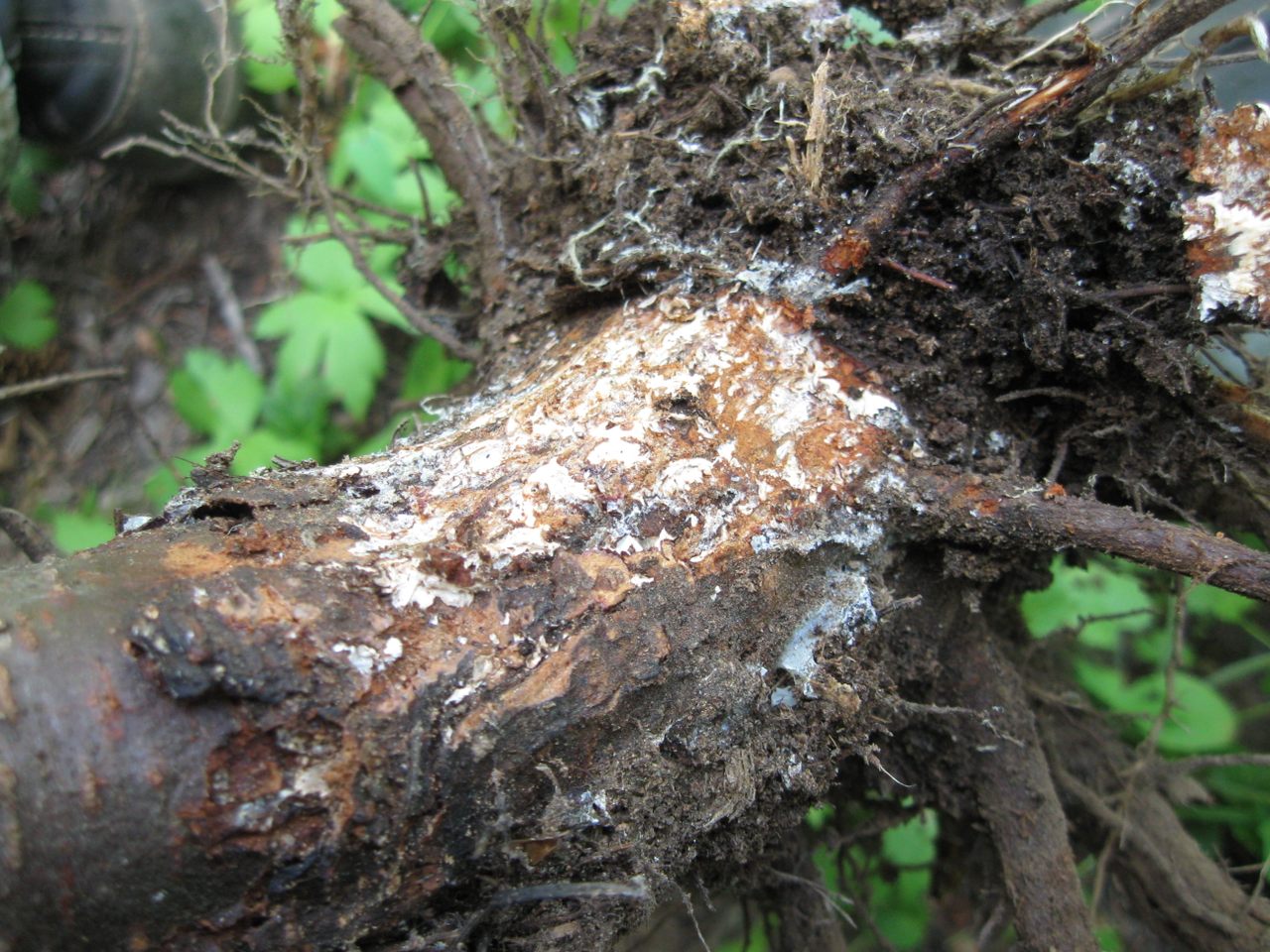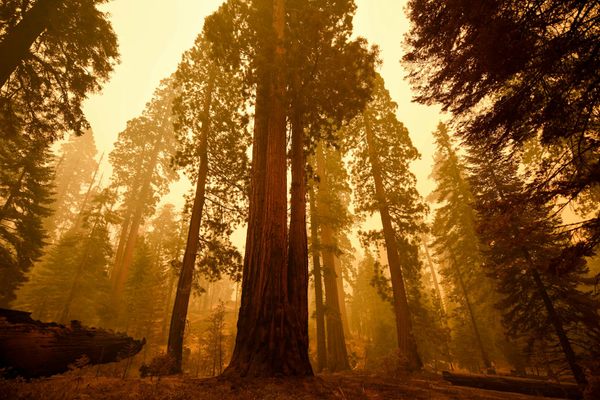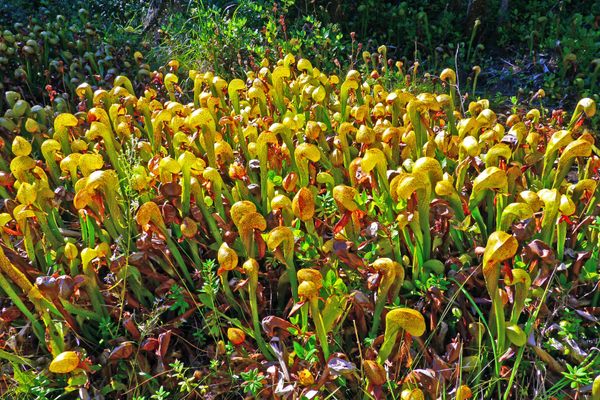What the World’s Largest Organism Reveals About Fires and Forest Health
In Oregon, the Humongous Fungus plays a complex role in an ecosystem reshaped by humans.
Under the Blue Mountains of Oregon lurks something massive and prehistoric. Yet the largest recorded organism on Earth, weighing more than 200 blue whales and dwarfing even Pando, Utah’s famous grove of quaking aspens, is nearly invisible to the untrained eye. It’s a single, genetically identifiable specimen of honey mushroom, or Armillaria ostoyae, that has been growing for thousands of years.
Nicknamed the Humongous Fungus, it covers nearly four square miles within Malheur National Forest and weighs perhaps 7,500 tons (some estimates range as high as 35,000 tons). The fungus likely attained its record-setting dimensions in part thanks to conditions created by 20th century forest management. And it continues to grow, expanding mostly underground in networks of thin filaments called mycelia. As the fungus spreads, it moves up into trees, hidden beneath their bark. It then slowly eats away at its host, often killing the tree and then continuing to munch on the dead wood for decades. More than just an insidious parasite, the Humongous Fungus is a symbol of an ailing, at-risk forest, unintended consequences of fire suppression, and the challenge of restoring an ecosystem’s health.
“If there were no trees dying, I wouldn’t have a job,” says forest pathologist Mike McWilliams, who calls himself the unofficial tour guide of the massive fungus. “But I like this thing because it’s super interesting.”
McWilliams, whose official duties center around conservation efforts at Malheur, meets visiting researchers (and the occasional curiosity seeker) along U.S. Highway 26, where a country store under towering pines advertises its famous huckleberry ice cream and buffalo burgers. From there, he leads the way along one Forest Service gravel road and then another. Eventually, the party must get out to hike.
Soon, dense forest gives way to a balding hillside. The few trees here are more spread out, and some are clearly dying—the work not of the Humongous Fungus, but a smaller relative. In Malheur, there are several different armillaria specimens, and it’s hard to tell with boots on the ground where one fungus ends and another begins. So researchers collect samples and map them genetically.
McWilliams continues driving, following dirt roads deeper into the forest, where the trees become smaller and closer together. The ground is littered with fallen trees and brush, what foresters call surface fuel. Then, at last, the tour arrives at the main attraction: the Humongous Fungus.

It’s easier to see the decay that Malheur’s most famous resident leaves behind than the fungus itself. What should be a thick and thriving forest is instead a collection of toppled trees, with many more dying. McWilliams uses his Pulaski, an ax-like forestry tool, to chip away at bark and reveal subtle, cream-colored fans on the exposed wood: evidence of the fungus spreading within an infected fir.
“Part of the reason [the Humongous Fungus] got so big is because of the history of fire suppression,” McWilliams says, referring to the dominant tenet of the last century of forest management. “Fires would have reduced the proportion of highly susceptible hosts, and you’d have a functional, healthy forest there.”
Just as fire has an important role in a forest ecosystem, so do various species of fungus. Simply put, terrestrial forests couldn’t exist without fungi. Some fungi exchange nutrients with plant roots in return for the sugars that come from photosynthesis. The ponderosa pine, a fire-resistant tree with reddish bark and a distinctive butterscotch smell, requires fungal assistance as a vulnerable seedling: It can grow to more than 100 feet tall, but it couldn’t make it to one foot without fungi, which help keep surrounding soil moist and ferry nutrients through the soil to the young tree’s roots.

A. ostoyae, the Humongous Fungus species, isn’t one of these beneficial fungi—at least, not for the trees it infects during the parasitic stage of its life cycle, eventually killing them. But during its saprophytic stage, when it feeds off its dead host, armillaria, like many other fungi, facilitates the crucial process of decomposition and helps return resources to the soil; we now know it’s what makes the fungus important to the overall ecosystem.
“There’s been an increase in understanding of how fungal pathogens play an important role in the forest: They remove the weakened trees and aid a resistant and vigorous pool of tree genetics,” says Oregon State University regional wildland fire specialist Ariel Cowan, who studies the intersection of soil health, wildfires, and fungi.
Improved knowledge about the positive role of armillaria is part of an emerging, broader view of forest ecosystems. As scientists learn more about a forest’s natural defenses against fire and other threats, and its ability to regenerate after being damaged, those mechanisms are being incorporated into a new way of forest management. “The definition of forest health is different and more holistic today than it was in previous times of forestry,” Cowan says.
Cowan’s own career choices are reflective of that more comprehensive approach: She took a break from academia to work as a wildland firefighter. She wanted to understand fire’s behavior firsthand, and to experience the impact humans have on overall forest health.
Before humans arrived in what’s now the American West, fires resulting from lightning strikes regularly cleared out scrub and debris in the underbrush. Trees grew further apart, at irregular intervals rather than the neat grid of modern forest plantations, which made it harder for fire and pathogens—even giant fungi—to move unchecked from tree to tree.
The first humans to enter the western forests learned the rhythms of these ecosystems over millennia. In several regions, Native American tribes set fires regularly to remove excess brush and assist fire-adapted species, such as the lodgepole pine, which has seeds that require the extreme heat of a fire to sprout. This traditional approach to forest management minimized surface fuel created by a scrubby, cluttered understory. When a lightning strike ignited a blaze naturally, it would not become intense enough to threaten established trees with thick bark and soaring canopies that provided the roof of the entire ecosystem. The forest continued to protect itself, with an assist from the people who relied on it and respected its natural rhythms.
The cycle broke when European settlers forced Indigenous communities off their lands throughout the West, and began managing the forests to suit their own needs, including for cattle grazing and timber. Logging projects left piles of organic detritus on the forest floor as ready fuel. When a fire inevitably broke out, attempts to control it were often disorganized.
In 1910, one of the most catastrophic fires in history, called the Big Burn, scorched 3 million acres across Idaho, Montana, and Oregon, and killed more than 80 people. The monstrous fire “cemented in the American psyche that fire is bad and should be put out at all costs,” says Paul Hessburg, a fire ecologist with the U.S. Forest Service.

In the 1930s, the government poured resources into fire suppression as part of large-scale public investments and job creation programs. Even then, some foresters were wary of removing fires from the landscape entirely. Harold Weaver, an Oregonian who studied prescribed burnings, thought taking fires out of the ecosystem could have terrible, unintended consequences.
Despite concerns raised by Weaver and others in the field, fire suppression became a cornerstone of forest management. And at first, coinciding with a relatively cool, wet period, it seemed to work. Fires across the American West were limited and generally controllable. For about 50 years, this fire regime was presumed to be normal. The main goal of the forest service during this era was to support the timber industry and, for decades, it thrived in a stable, fire-free environment. Forests were first cleared of old growth, because large trees made more money than small trees. New-growth trees were then seeded on a grid-like pattern, and reliable, fast-growing species, such as fir trees, were preferred.
As a result, there are now more fir trees in western forests than there should be. Douglas firs and grand firs, specifically, are common—and are not adapted to withstand fires. Though these firs are native, they are proliferating in “non-native numbers,” says McWilliams. A 2017 study in the journal Trees, Forests and People found that firs and other species lacking fire adaptations are nine times more common today than in past centuries—in some areas, they comprise more than 90 percent of a forest’s tree mass.
Douglas firs and grand firs have allowed something else to happen. These species are highly susceptible to infections of the fungus A. ostoyae. While the Humongous Fungus predates 20th century forest management through fire suppression by thousands of years, it probably would not have gotten so enormous without it.

The A. ostoyae specimen known as the Humongous Fungus is not alone; in the late 20th century, another outsized armillaria, this one in Washington State, achieved similar proportions. “I always say that this is the largest documented organism,” McWilliams says. “It’s highly likely that there’s a bigger one out there somewhere.”
Ironically, these giant fungi slowly destroying the forest may also be tools to help it recover from a century of problematic fire management—and to protect it from a changing climate that’s hotter, drier, and at greater risk for catastrophic fires.
While it’s unclear whether a fire burning above it would damage the Humongous Fungus itself, McWilliams notes that in areas of the forest where armillaria infection is most advanced, trees are spaced further apart and organic material on the ground has been broken down. As the Humongous Fungus and other armillaria expand at a rate of up to 5 feet per year in all directions, they chomp through the highly susceptible Douglas firs and grand firs—creating space, and filtering nutrients back into the soil, to support the potential growth of species more resistant to fire (and fungus). Eventually, armillaria could clean out all the overgrowth and natural debris on the forest floor—but not on a timeline that’s acceptable to humans.
Now, more forest management experts are starting to reintroduce fire into the landscape across the American West through small, highly controlled fires known as prescribed burns. Intentionally setting fires can be politically tricky, even in communities where people understand the benefits, but, says McWilliams, “You’re going to have smoke one way or the other. Do you want a little bit of smoke one day or a lot of smoke when you can’t control it?”
He and other forest scientists hope that we can restore our symbiotic relationship with the forest, aiding the cycles of natural fires that benefit many fire-adapted species, and respecting the ecosystem’s natural rhythms.
Meanwhile, the Humongous Fungus of Malheur National Forest will keep growing.






































Follow us on Twitter to get the latest on the world's hidden wonders.
Like us on Facebook to get the latest on the world's hidden wonders.
Follow us on Twitter Like us on Facebook